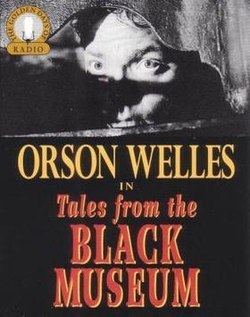 | ||
Similar Black Museum, National Museum of Crime, Scotland Yard, Barts Pathology Museum, Royal Cinema | ||
The black museum bill waddell documentary 1988 complete
The Black Museum was a radio crime-drama program produced by Harry Towers in London. It was broadcast in Europe on Radio Luxembourg, a commercial radio station, and was not broadcast by the BBC until 1991.
Contents
- The black museum bill waddell documentary 1988 complete
- Programme format and themes
- Broadcast history
- Episodes
- Cases
- Relationships and differences with source material
- Listen to
- References
In 1946 Harry Towers and his mother, Margaret Miller Towers, started a company called Towers of London that sold various syndicated radio shows around the world, including The Lives of Harry Lime, with Orson Welles, The Secrets of Scotland Yard, with Clive Brook, Horatio Hornblower, with Michael Redgrave, and a series of Sherlock Holmes stories featuring John Gielgud as Holmes, Ralph Richardson as Watson and Welles as Moriarty.
The Black Museum was based on real-life cases from the files of Scotland Yard's Black Museum. The program was transcribed in 1951 and was broadcast in the United States January 1-December 31, 1952, on Mutual. More than 500 of the network's stations carried it. Ira Marion was the scriptwriter, and music for the series was composed and conducted by Sidney Torch.
Orson Welles was both host and narrator for stories of horror and mystery, based on Scotland Yard's collection of murder weapons and various ordinary objects once associated with historical true crime cases. The show's opening began:
Programme format and themes
Walking through the museum, Welles would pause at one of the exhibits, and his description of an artifact served as a device to lead into a wryly-narrated dramatised tale of a brutal murder or a vicious crime. In the closing: "Now until we meet again in the same place and I tell you another tale of the Black Museum", Welles would conclude with his signature radio phrase, "I remain, as always, obediently yours".
With the story themes deriving from objects in the collection (usually with the names of the people involved changed but the facts remaining true to history), the 52 episodes had such titles as "The Tartan Scarf" and "A Piece of Iron Chain" or "Frosted Glass Shards" and "A Khaki Handkerchief". An anomaly to the series was an episode called "The Letter" as this was the only story not about murder, but about forgery.
Broadcast history
In the United States, the series aired on the Mutual Network between January 1 and December 30, 1952. It was rebroadcast on KABC, Los Angeles, California, in 1963-1964 and on KUAC (FM) in Fairbanks, Alaska, in 1967.
Beginning May 7, 1953, it was also broadcast over Radio Luxembourg sponsored by the cleaning products Dreft and Mirro. Since the BBC carried no commercials, Radio Luxembourg aired sponsored programs at night to England.
In the United States, there was a contemporary programme called Whitehall 1212 written and directed by Wyllis Cooper and broadcast by NBC, that was similar in scope to The Black Museum. It was hosted by Chief Superintendent John Davidson, curator of the Black Museum. It used many of the same picked cases as The Black Museum, and it nearly mirrored its broadcast run. The two shows were different in the respect that while Whitehall 1212 told the story of a case entirely from the point of view of the police starting from the crime scene, The Black Museum was more heavily dramatized and played out scenes of the actual murders and included scenes from the criminal's point of view.>
Episodes
The following episodes were broadcast:
Cases
The below-listed Metropolitan Police cases were used as the basis for episodes of The Black Museum:
Episodes yet to be matched with true case histories are:
